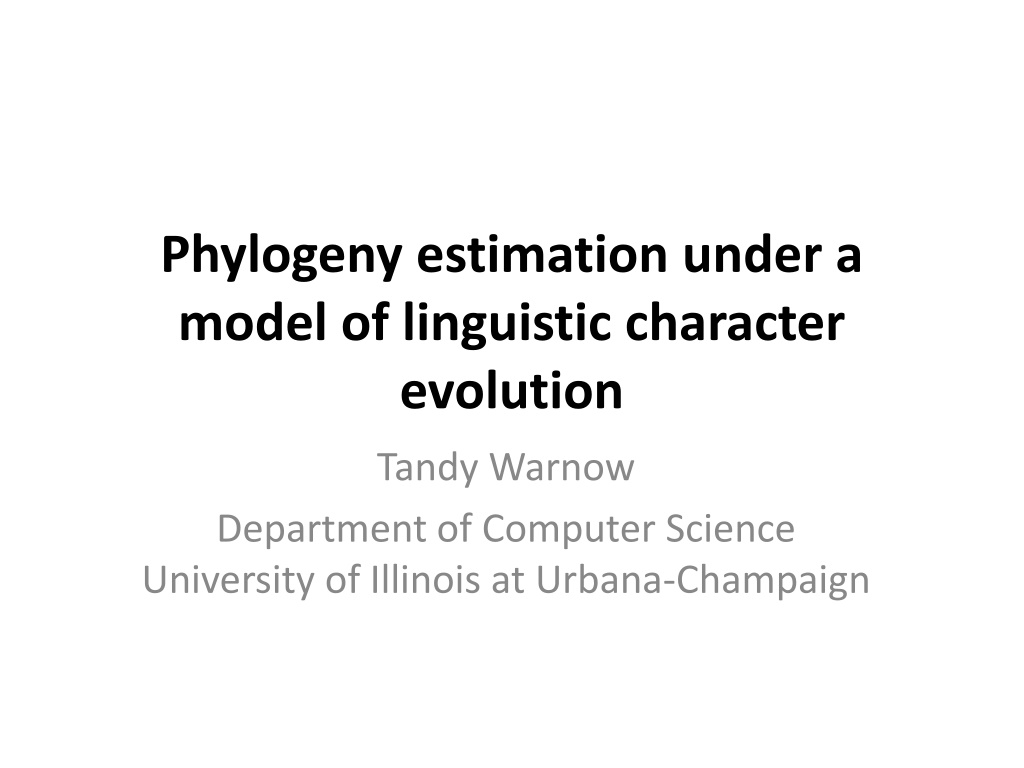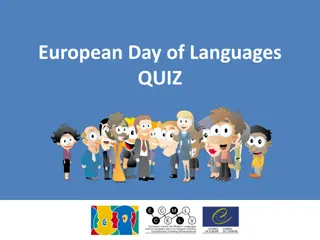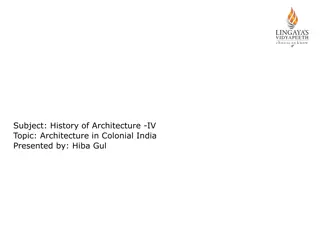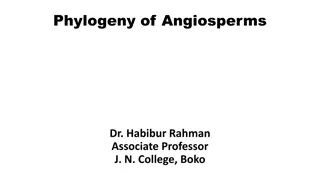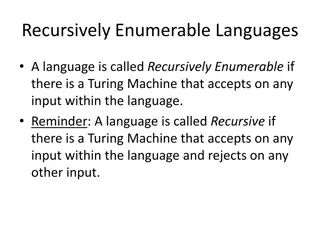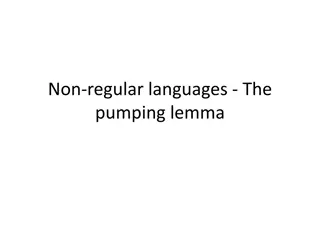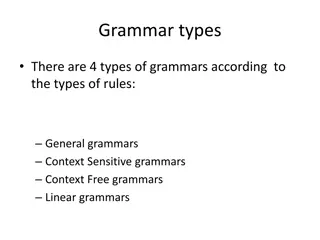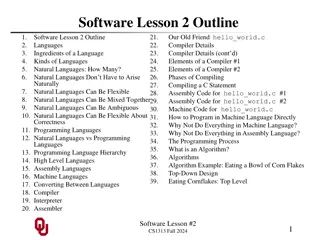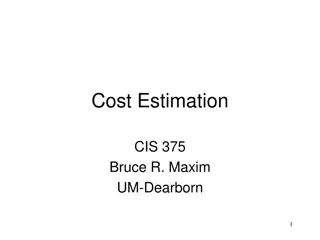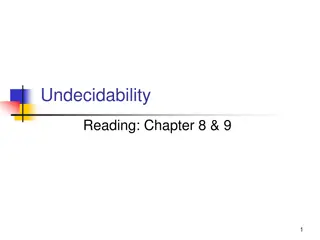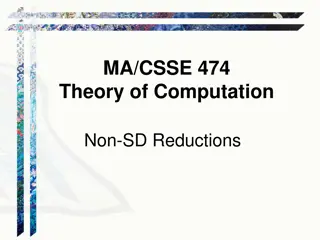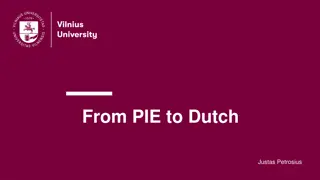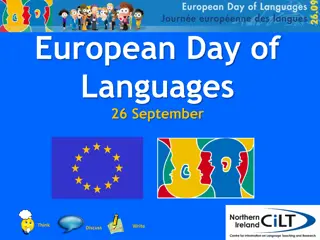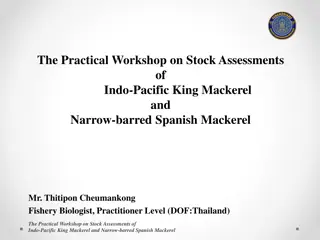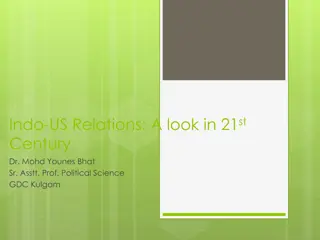Evolution of Indo-European Languages through Phylogeny Estimation
Explore the evolution of Indo-European languages through phylogeny estimation under a model of linguistic character evolution. Follow the Computational Historical Linguistics Project's collaboration that began in 1994, leading to the development of methods and studies on homoplasy-free evolution and possible Indo-European tree structures. Discover the Gray and Atkinson method utilizing lexical data to analyze linguistic evolution.
- Phylogeny Estimation
- Linguistic Evolution
- Indo-European Languages
- Computational Historical Linguistics
Download Presentation

Please find below an Image/Link to download the presentation.
The content on the website is provided AS IS for your information and personal use only. It may not be sold, licensed, or shared on other websites without obtaining consent from the author. Download presentation by click this link. If you encounter any issues during the download, it is possible that the publisher has removed the file from their server.
E N D
Presentation Transcript
Phylogeny estimation under a model of linguistic character evolution Tandy Warnow Department of Computer Science University of Illinois at Urbana-Champaign
The Computational Historical Linguistics Project http://web.engr.illinois.edu/~warnow/histling.html Collaboration with Don Ringe began in 1994; 17 papers since then, and two NSF grants. Dataset generation by Ringe and Ann Taylor (then a postdoc with Ringe, now Senior Lecturer at York University). Method development with Luay Nakhleh (then my student, now Chair and Professor at Rice University), Steve Evans (Prof. Statistics, Berkeley). Simulation study with Francois Barbanson (then my postdoc).
Indo-European languages From linguistica.tribe.net
Homoplasy-free evolution When a character changes state, it changes to a new state not in the tree; i.e., there is no homoplasy (character reversal or parallel evolution) First inferred for weird innovations in phonological characters and morphological characters in the 19th century, and used to establish all the major subgroups within IE (But other characters also evolve without homoplasy) 0 0 1 0 0 0 0 1 1
Possible Indo-European tree (Ringe, Warnow and Taylor 2000) Anatolian Vedic Greek Italic Iranian Celtic Tocharian Germanic Armenian Baltic Slavic Albanian
Another possible Indo-European tree (Gray & Atkinson, 2004) Italic Gmc. Celtic Baltic Slavic Alb. Indic Iranian Armenian Greek Toch. Anatolian
Gray and Atkinson Method Used only lexical data Binary-encoding of all multi-state character data to perform the analysis Assumes the CFN (Cavender-Farris-Neyman) model of binary sequence evolution, in which all characters evolve identically and independently down the model tree Uses MCMC to sample from a distribution (specifically used MrBayes software)
This talk Introduction to molecular systematics (very fast) Linguistic data and the Ringe-Warnow analyses of the Indo- European language family Perfect Phylogenetic Networks (Nakhleh et al., Language 2005) Comparison of different phylogenetic methods on Indo-European datasets (Nakhleh et al., Transactions of the Philological Society 2005) Stochastic model of linguistic character evolution (Warnow et al., MacDonald Institute for Archaeological Research, 2006) Simulation study evaluating different phylogenetic methods (Barban on et al., Diachronica 2013) Discussion and Future work
DNA Sequence Evolution (Idealized) -3 mil yrs AAGACTT AAGACTT -2 mil yrs AAGGCCT AAGGCCT AAGGCCT AAGGCCT TGGACTT TGGACTT TGGACTT TGGACTT -1 mil yrs AGGGCAT AGGGCAT AGGGCAT TAGCCCT TAGCCCT TAGCCCT AGCACTT AGCACTT AGCACTT today AGGGCAT AGGGCAT TAGCCCA TAGCCCA TAGACTT TAGACTT AGCACAA AGCACAA AGCGCTT AGCGCTT
Markov Models of DNA Sequence Evolution The different sites are assumed to evolve i.i.d. down the model tree (with rates that are drawn from a gamma distribution).
Markov Models of DNA Sequence Evolution The different sites are assumed to evolve i.i.d. down the model tree (with rates that are drawn from a gamma distribution). Simplest site evolution model (Jukes-Cantor, 1969): The model tree T is binary and has substitution probabilities p(e) on each edge e. The state at the root is randomly drawn from {A,C,T,G} (nucleotides) If a site (position) changes on an edge, it changes with equal probability to each of the remaining states. The evolutionary process is Markovian. More complex models (such as the General Markov model) are also considered, often with little change to the theory.
CFN Model of Binary Sequence Evolution The different sites are assumed to evolve i.i.d. down the model tree (with rates that are drawn from a gamma distribution). CFN model: (CFN: Cavender, Farris, Neyman): The model tree T is binary and has substitution probabilities p(e) on each edge e. The state at the root is randomly drawn from {0,1} (presence/absence) If a site (position) changes on an edge, it changes with equal probability to each of the remaining states. The evolutionary process is Markovian. Used for modelling trait evolution (presence/absence)
Markov Models in Biology All standard models have a finite number of states (2 for traits, 4 for DNA/RNA, 20 for aminoacids), and hence lots of homoplasy All characters (sites in an alignment) evolve identically and independently (iid) down the tree
Statistical Consistency and Identifiability error Data
State of the Art for Molecular Systematics Many distance-methods are statistically consistent (but not UPGMA) Parsimony is not statistically consistent Maximum likelihood and Bayesian MCMC are statistically consistent and highly favored
Model of Linguistic Character Evolution (Warnow, Evans, Ringe, and Nakhleh, 2006) Three types of characters: lexical, phonological, and morphological Infinite number of possible states Character evolution is not iid Borrowing can occur Limited homoplasy enables identifiability Statistically consistent methods presented
Our main points Biomolecular data evolve differently from linguistic data, and linguistic models and methods should not be based upon biological models. Better (more accurate) phylogenies can be obtained by formulating models and methods based upon linguistic scholarship, and using good data. All methods, whether explicitly based upon statistical models or not, need to be carefully tested.
Indo-European languages From linguistica.tribe.net
Homoplasy-free evolution When a character changes state, it changes to a new state not in the tree; i.e., there is no homoplasy (character reversal or parallel evolution) First inferred for weird innovations in phonological characters and morphological characters in the 19th century, and used to establish all the major subgroups within IE 0 0 1 0 0 0 0 1 1
Historical Linguistic Data A character is a function that maps a set of languages, L, to a set of states. Three kinds of characters: Phonological (sound changes) Lexical (meanings based on a wordlist) Morphological (especially inflectional)
Sound changes Many sound changes are natural, and should not be used for phylogenetic reconstruction. Others are bizarre, or are composed of a sequence of simple sound changes. These are useful for subgrouping purposes. Example: Grimm s Law. 1. Proto-Indo-European voiceless stops change into voiceless fricatives. 2. Proto-Indo-European voiced stops become voiceless stops. 3. Proto-Indo-European voiced aspirated stops become voiced fricatives.
An Indo-European lexical character: hand. Data. Hittite kissar Lithuanian rank Old Prussian r nkan (acc.) Armenian je n Old English hand Latvian r ka Greek /k :r/ Old Irish l m Gothic handus Albanian dor Latin manus Old Norse h nd Tocharian B ar Luvian ssaris OHG hant Vedic h stas Lycian izredi (instr.) Welsh llaw Avestan zast Tocharian A tsar Oscan manim (acc.) OCS r ka Old Persian dasta Umbrian manf (acc. pl.)
Semantic slot for hand coded (Partitioned into cognate classes)
Proto-Indo-European *plh2meh2flat hand (cf. Homeric Greek palm:) > Proto-Celtic *l m hand > Old Irish l m > Welch llaw Proto-Germanic *handuz hand > Gothic handus > Runic Norse *handu (ending influenced by a different noun class) > Old Norse h nd > Proto-West Germanic *handu > Old English hand > Old High German hant Proto-Italic *man- hand > Latin manus (transferred into the u-stems) > Proto-Sabellian *man- > Oscan *manis > *mans, accusative manim (transf. into the i-stems) > Umbrian *man-, accusative plural manf
Lexical characters can also evolve without homoplasy For every cognate class, the nodes of the tree in that class should form a connected subset - as long as there is no undetected borrowing nor parallel semantic shift. 1 1 1 0 0 0 1 1 2
Our (RWT) Data Ringe & Taylor (2002) 259 lexical 13 morphological 22 phonological These data have cognate judgments estimated by Ringe and Taylor, and vetted by other Indo- Europeanists. (Alternate encodings were tested, and mostly did not change the reconstruction.) Polymorphic characters, and characters known to evolve in parallel, were removed.
Differences between different characters Lexical: most easily borrowed (most borrowings detectable), and homoplasy relatively frequent (we estimate about 25- 30% overall for our wordlist, but a much smaller percentage for basic vocabulary). Phonological: can still be borrowed but much less likely than lexical. Complex phonological characters are infrequently (if ever) homoplastic, although simple phonological characters very often homoplastic. Morphological: least easily borrowed, least likely to be homoplastic.
Our methods/models Ringe & Warnow Almost Perfect Phylogeny : most characters evolve without homoplasy under a no-common- mechanism assumption (various publications since 1995) Ringe, Warnow, & Nakhleh Perfect Phylogenetic Network : extends APP model to allow for borrowing, but assumes homoplasy-free evolution for all characters (Language, 2005) Warnow, Evans, Ringe & Nakhleh Extended Markov model : parameterizes PPN and allows for homoplasy provided that homoplastic states can be identified from the data (MacDonald Institute for Archaeological Research, 2006)
First analysis: Almost Perfect Phylogeny The original dataset contained 375 characters (336 lexical, 17 morphological, and 22 phonological). We screened the dataset to eliminate characters likely to evolve homoplastically or by borrowing. On this reduced dataset (259 lexical, 13 morphological, 22 phonological), we attempted to maximize the number of compatible characters while requiring that certain of the morphological and phonological characters be compatible. (Computational problem NP-hard.)
Indo-European Tree (95% of the characters compatible) Anatolian Vedic Greek Italic Iranian Celtic Tocharian Germanic Armenian Baltic Slavic Albanian
Second attempt: PPN We explain the remaining incompatible characters by inferring previously undetected borrowing . We attempted to find a PPN (perfect phylogenetic network) with the smallest number of contact edges, borrowing events, and with maximal feasibility with respect to the historical record. (Computational problems NP-hard). Our analysis produced one solution with only three contact edges that optimized each of the criteria. Two of the contact edges are well-supported.
Modelling borrowing: Networks and Trees within Networks
Perfect Phylogenetic Network (all characters compatible) Anatolian Vedic Greek Italic Iranian Celtic Tocharian Germanic Armenian Baltic Slavic Albanian L. Nakhleh, D. Ringe, and T. Warnow, LANGUAGE, 2005
Comments This network is very tree-like (only three contact edges needed to explain the data. Two of the three contact edges are strongly supported by the data (many characters are borrowed). If the third contact edge is removed, then the evolution of the remaining (two) incompatible characters needs to be explained. Probably this is parallel semantic shift.
Other IE analyses Note: many reconstructions of IE have been done, but produce different histories which differ in significant ways Possible issues: Dataset (modern vs. ancient data, errors in the cognancy judgments, lexical vs. all types of characters, screened vs. unscreened) Translation of multi-state data to binary data Reconstruction method
Another possible Indo-European tree (Gray & Atkinson, 2004) Only lexical data, not well curated Binary encoding! Italic Gmc. Celtic Baltic Slavic Alb. Indic Iranian Armenian Greek Toch. Anatolian
Gray and Atkinson Method Uses MCMC to sample from a distribution (specifically used MrBayes software) Assumes the CFN (Cavender-Farris-Neyman) model of binary sequence evolution, in which all characters evolve identically and independently down the model tree Used only lexical data Binary-encoding of all multi-state character data to perform the analysis
Semantic slot for hand coded (Partitioned into cognate classes)
Binary Encoding of Multi-state Characters Imagine you have a lexical character (semantic slot) with four cognate classes This is replaced by four characters, one for each cognate class The four characters are now assumed to evolve i.i.d. under the CFN model of binary character evolution 0 represents absence, 1 represents presence Problems with binary encoding: (0,0,0,0 can occur), indicating no word for this semantic slot (1,1,1,1), indicating all four words for the semantic slot (i.e., the model allows unbounded polymorphism) Problem with CFN model applied to binary encoding Model assumes appearance and loss of cognates are independent of other cognates (unrealistic)
Another possible Indo-European tree (Gray & Atkinson, 2004) Only lexical data, not well curated Binary encoding! Italic Gmc. Celtic Baltic Slavic Alb. Indic Iranian Armenian Greek Toch. Anatolian
Possible Indo-European tree (Ringe, Warnow and Taylor 2000) Three types of data, highly curated Multi-state! Anatolian Vedic Greek Italic Iranian Celtic Tocharian Germanic Armenian Baltic Slavic Albanian
Different methods/data give different answers. We don t know which answer is correct. Which method(s)/data should we use?
The performance of methods on an IE data set, Transactions of the Philological Society, L. Nakhleh, T. Warnow, D. Ringe, and S.N. Evans, 2005) Observation: Different datasets (not just different methods) can give different reconstructed phylogenies. Objective: Explore the differences in reconstructions as a function of data (lexical alone versus lexical, morphological, and phonological), screening (to remove obviously homoplastic characters), and methods. However, we use a better basic dataset (where cognancy judgments are more reliable).
Phylogeny reconstruction methods Perfect Phylogenetic Networks (Ringe, Warnow, and Nakhleh) Other network methods Neighbor joining (distance-based method) UPGMA (distance-based method, same as glottochronology) Maximum parsimony (minimize number of changes) Maximum compatibility (weighted and unweighted) Gray and Atkinson (Bayesian estimation based upon presence/absence of cognates, as described in Nature 2003)
Phylogeny reconstruction methods Perfect Phylogenetic Networks (Ringe, Warnow, and Nakhleh) Other network methods Neighbor joining (distance-based method) UPGMA (distance-based method, same as glottochronology) Maximum parsimony (minimize number of changes) Maximum compatibility (weighted and unweighted) Gray and Atkinson (Bayesian estimation based upon presence/absence of cognates, as described in Nature 2003)
Four IE datasets Ringe & Taylor The screened full dataset of 294 characters (259 lexical, 13 morphological, 22 phonological) The unscreened full dataset of 336 characters (297 lexical, 17 morphological, 22 phonological) The screened lexical dataset of 259 characters. The unscreened lexical dataset of 297 characters.
Results: Likely Subgroups Other than UPGMA, all methods reconstruct the ten major subgroups Anatolian + Tocharian (that under the assumption that Anatolian is the first daughter, then Tocharian is the second daughter) Greco-Armenian (that Greek and Armenian are sisters) Nothing else is consistently reconstructed. In particular, the choice of data (lexical only, or also morphology and phonological) has an impact on the final tree. The choice of method also has an impact! differ significantly on the datasets, and from each other.
Other observations UPGMA (i.e., the tree-building technique for glottochronology) does the worst (e.g. splits Italic and Iranian groups). The Satem Core (Indo-Iranian plus Balto-Slavic) is not always reconstructed. Almost all analyses put Italic, Celtic, and Germanic together: The only exception is Weighted Maximum Compatibility on datasets that include highly weighted morphological characters.ffer significantly on the datasets, and from each other.
Different methods/data give different answers. We don t know which answer is correct. Which method(s)/data should we use?
Stochastic model of language evolution (Warnow et al., 2006) Model based on linguistic scholarship Borrowing between languages Each character evolves with its own parameters (not identically to the other characters) When a character changes state, it usually attains a new state (so that the number of states is unbounded) Some homoplasy is allowed (but just one known homoplastic state per character) This is a statistically identifiable model (if not too much borrowing)
